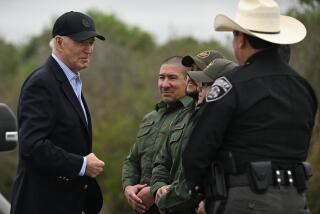Op-Ed: The new frontier of race and immigration: Middle America

The violence perpetrated by white supremacists in Charlottesville, Va., on Aug. 12 represents the most extreme manifestation of the cultural anxiety latent in many American cities and towns that are confronted by demographic change.
Peering at maps of concentrated blue enclaves and the vast red countryside, it may seem that there are two Americas — one that welcomes diverse peoples and facilitates their integration into the United States, and another that perceives diverse peoples as a threat to the cultural composition of the country.
We both keep one foot in each America. One of us is the child of a refugee father and a mother from rural Georgia, who graduated from a Los Angeles public school, lives in Manhattan and focused his recent research on white working-class people’s marginality in the Rust Belt. The other grew up in the Philadelphia suburbs, spent a year abroad in Ecuador before moving to Tennessee and later Atlanta, married the daughter of Rust Belt dairy farmers and has focused his career on reducing fear of immigrants in conservative America.
For us, the two Americas are not as separate as many think.
A growing number of communities in Middle America have already begun to act as models for this paradigm shift in immigrant incorporation.
The big cities where we live have become the critical agents of globalization — recruiting immigrants as part of a global economy and multi-ethnic society that is more closely connected with other cities worldwide than their geographic peripheries.
Yet as even newer immigrant destinations such as Denver and Washington, D.C., become congested, competitive and expensive, immigrants are seeking opportunities elsewhere.
Chances at a better life often emerge in post-industrial and post-agrarian regions. According to an analysis by the Wall Street Journal, the diversity index at least doubled in 244 U.S. counties between 2000 and 2015, and more than half of those counties were in Iowa, Indiana, Wisconsin, Illinois and Minnesota. Many of these newcomers were Latinos who migrated from Central America, in some cases via California and Texas.
These counties are motivated to bring in immigrants for many of the same reasons as traditional gateways: They are looking to fill gaps in their labor markets and expand their tax bases. In addition, many are looking to stave off, or reverse, population decline. However, many residents in these regions are wary of immigrants. They fear both labor competition and cultural transformation.
These tense regions of demographic change are largely responsible for the Trump revolution. The Wall Street Journal’s analysis reported that Trump won two out of every three voters in counties where the diversity index rose by 150% or more. Many of these places are in Ohio, Indiana, Georgia and North Carolina, as well as Michigan, Pennsylvania and Wisconsin — three states that Hillary Clinton lost by a total of 77,000 votes.
Fueled by nostalgia, Trump vowed to return white, working-class Americans to the center of the national conversation. But while his rhetoric consoled his supporters, he can do little to stem the pace and flow of the change that irks them.
That’s why it’s imperative to find paths to social cohesion in these new sites of immigrant settlement.
In earlier frontiers, public and civil society efforts focused on immigrants themselves —facilitating their language acquisition, their education, housing, healthcare and more general comfort. However, such approaches were akin to planting seeds in a field, and then ignoring the soil. In newer frontiers, society must also pay attention to the fears and concerns of long-time residents — the earth around them.
And indeed, a growing number of communities in Middle America have already begun to act as models for this paradigm shift in immigrant incorporation. Over the last 10 years, cities such as Dayton, Ohio, St. Louis, Mo., and Boise, Idaho have facilitated comprehensive planning processes in which long-time residents were at the table as decisions were made about how newly arriving immigrants and refugees would be received.
From Detroit to Northwest Arkansas to — yes — Charlottesville, residents and leaders have shepherded similar efforts. And they’re working. For example, Dayton was able to reverse more than 50 years of population and economic decline by attracting immigrants. Now their once-shuttered city center is teeming with native- and immigrant-owned businesses. This renewed prosperity has reduced the fear of immigrants and deepened the community’s commitment to their incorporation.
In 160 communities that have signed agreements to advance immigrant inclusion, local city councils have passed 600 policies that boost integration by accommodating second languages, facilitating access to schools, sensitizing law enforcement agencies, and simplifying small business ownership for all.
Immigration isn’t just a coastal phenomenon: Middle American cities and towns are growing more diverse. The more agency longstanding residents have over how their communities receive immigrants, the more likely they are not to insist on facing the future by shifting into reverse.
Justin Gest is an assistant professor of public policy at George Mason University and author of “The New Minority: White Working Class Politics in an Age of Immigration and Inequality.” David Lubell is the founder and executive director of Welcoming America, a national nonprofit organization based in Atlanta.
Follow the Opinion section on Twitter @latimesopinion or Facebook.
More to Read
A cure for the common opinion
Get thought-provoking perspectives with our weekly newsletter.
You may occasionally receive promotional content from the Los Angeles Times.






